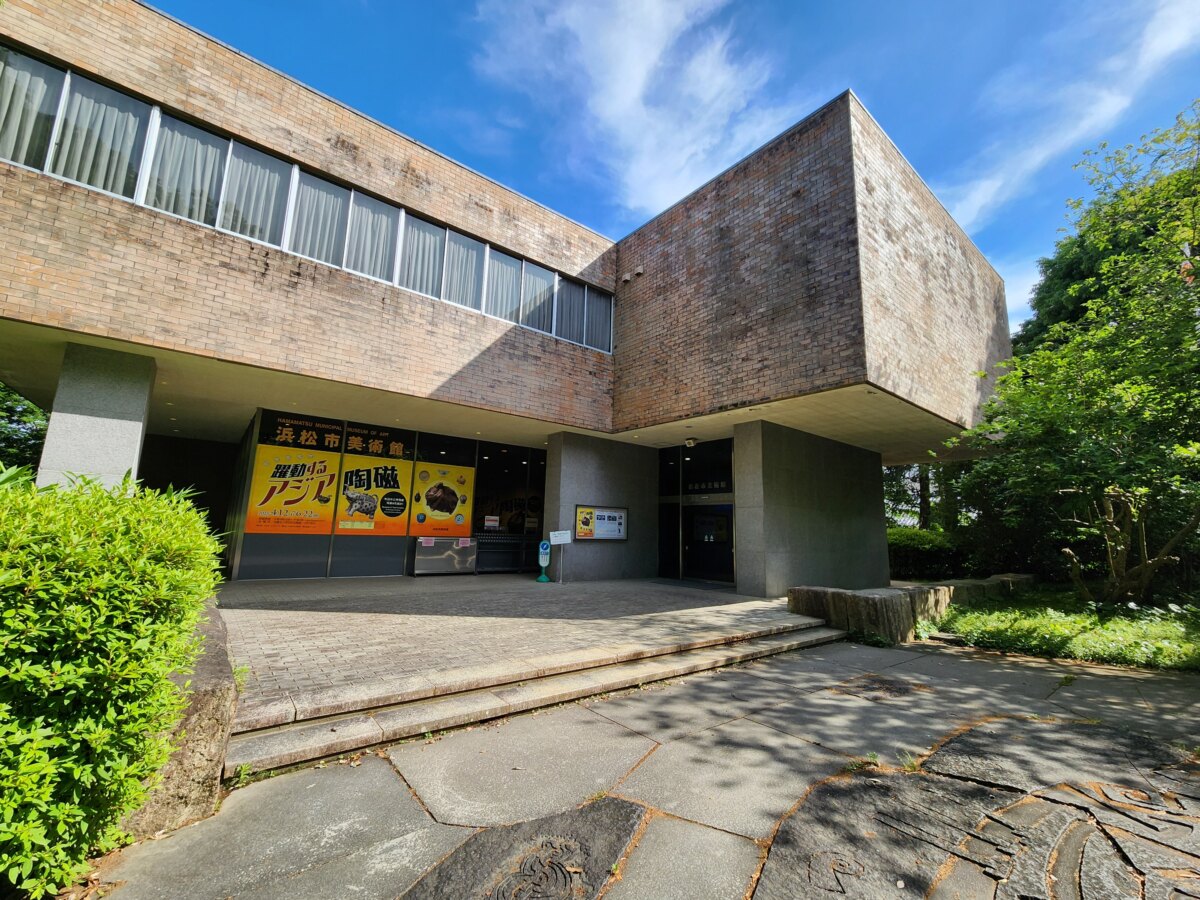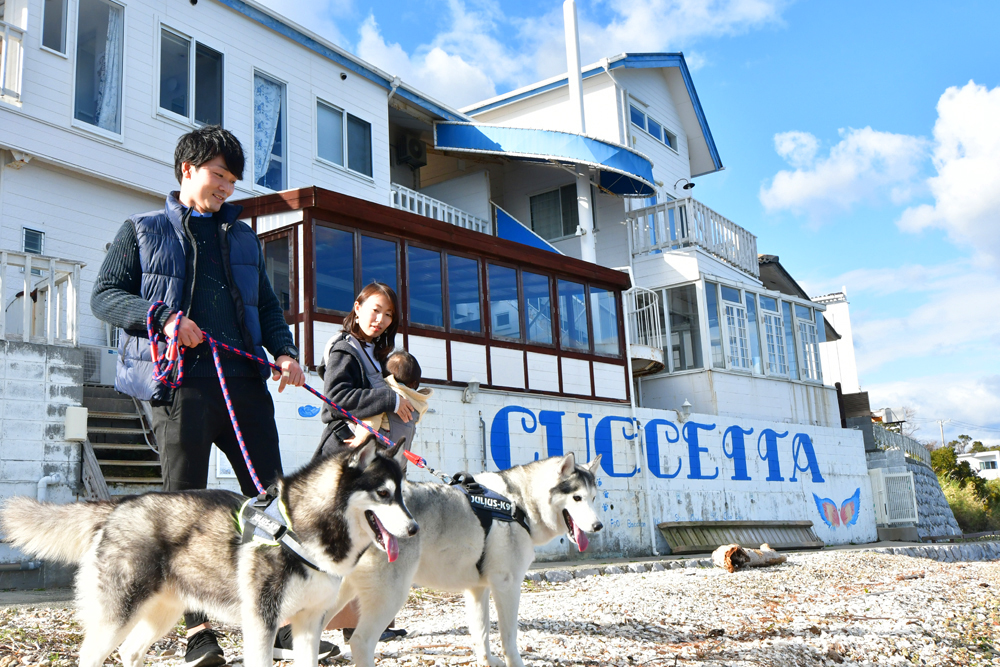Get to Know Hamamatsu
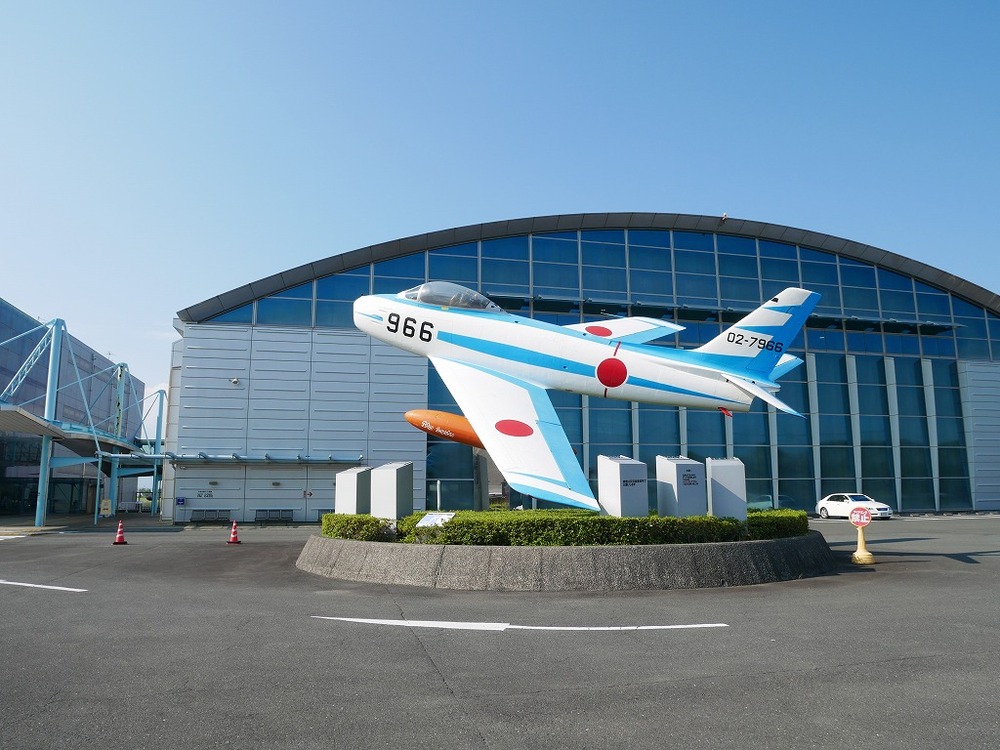
- Enjoy
Japan’s Only Air Self-Defense Force Museum: Enjoy Aircraft at Hamamatsu Air Park!
Have you heard of the Air Self-Defense Force Hamamatsu Public Relations Holl, popularly known as “Air Park,” a lively destination that attracts visitors from all over Japan?
Have you heard of the Air Self-Defense Force Hamamatsu Public Relations Holl, popularly known as “Air Park,” a lively destination that attracts visitors from all over Japan?
Inside this free-to-enter facility, you can enjoy a variety of exciting experiences, from immersive videos in the Full-Dome theater to flight simulations in fighter jet simulators!
This time, we’re diving into the charms of Air Park—a place that’s fun to visit not just on sunny days, but also when it’s rainy or windy!
What kind of place is Air Park?

The F-86F in Blue Impulse livery
Located about 5.2 km north-northwest of JR Hamamatsu Station.
Air Self-Defense Force Hamamatsu Public Relations Holl, affectionately known as “Air Park,” is a favorite among aviation and fighter jet enthusiasts.
Following a renovation in spring 2021, some of the exhibits were updated, making it an even more captivating destination.
Inside the facility, you’ll find a wide range of attractions: historic fighter jets, rescue and transport aircraft, and displays of equipment like missiles.
There’s also the full-dome theater with thrilling videos and a Blue Impulse Simple flight simulator, offering plenty of exciting experiences for visitors.
When you arrive, be sure to snap a commemorative photo in front of the F-86F in Blue Impulse colors!
The buildings inside Air Park are divided into the “Exhibition Hall”, the “Full-Dome Theater”, and the “Exhibit Hangar”.
The Exhibition Hall and Theater are located in the building on the left, while the Hangar is in the building on the right, just behind the F-86F.
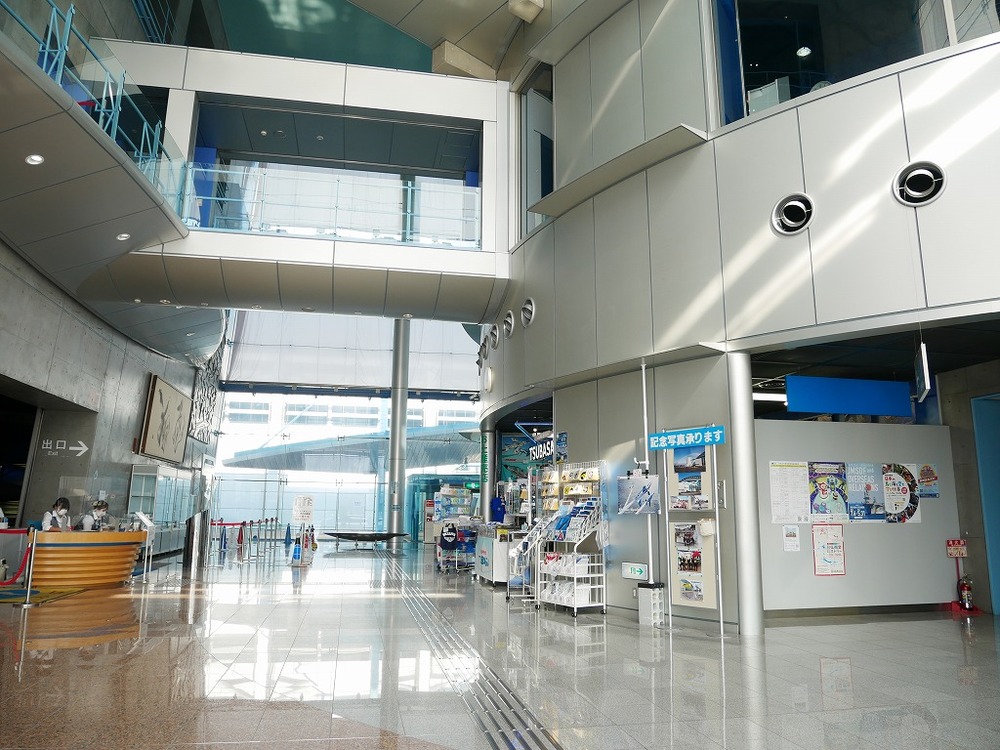
Inside the Exhibition Hall on the first floor, this is the view from the west side (by the windows) toward the east side (the entrance/exit). Note: Once you enter the hall, the view appears reversed left to right compared to this image.
The Exhibition Hall has three floors, and by exploring them all, you can learn about the missions and activities of the Japan Air Self-Defense Force, the mechanics of fighter jets, pilot gear, and the weapons carried on aircraft.
In addition to viewing the exhibits, you can also try out a simple simulator for a hands-on experience.
The Full-Dome Theater, known for its thrilling aerial footage from an altitude of 20,000 feet, operates on a set schedule, and admission requires a numbered ticket.
So if you’d like to watch the show, be sure to get a numbered ticket at the reception desk on the first floor of the Exhibition Hall.
It’s recommended to check the official website in advance for the screening schedule and program details.
★Official website (Japanese link): https://www.mod.go.jp/asdf/airpark/
I’ve visited the museum a couple of times before, but this was my first time since the renovation—so I couldn’t help feeling excited even before stepping inside!
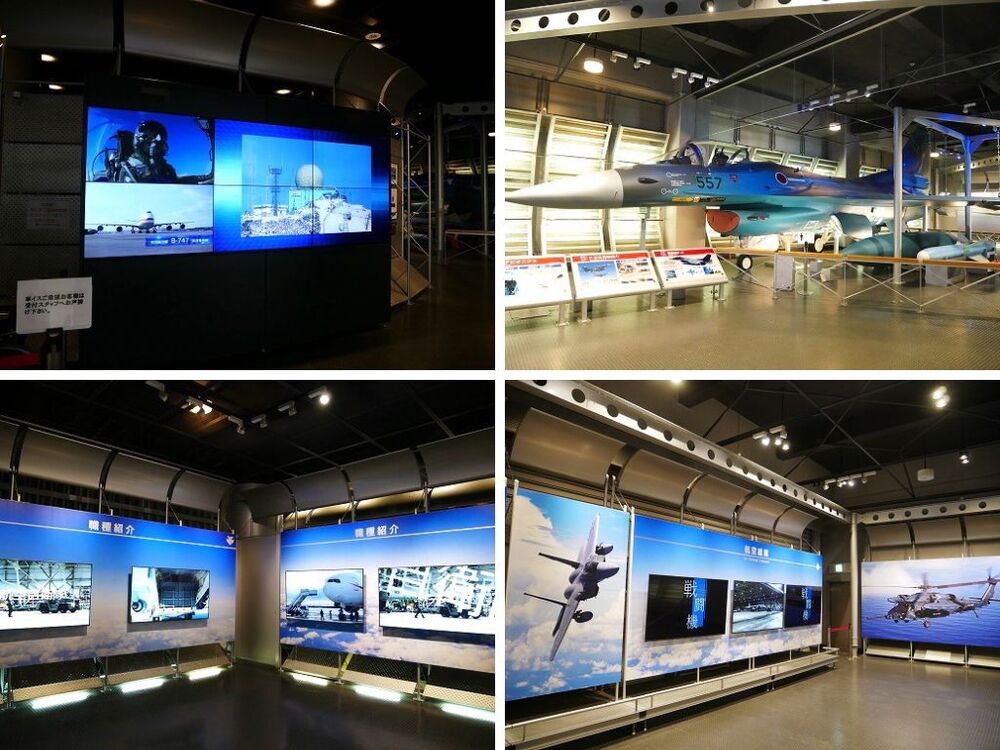
Top left: six-screen multi-display Top right: full-scale mockup of the F-2 fighter, repainted in production aircraft colors during the renovation
On the first floor of the Exhibition Hall, displays introduce the missions and activities of the Japan Air Self-Defense Force, as well as the mechanisms of fighter jets.
Right after entering from the reception area, visitors are greeted by a new welcome video displayed across six monitors—something that wasn’t there before the renovation.
Wait… a change right from the start!?
Surprised, I continued on, only to find that many of the displays had shifted from text-and-photo panels to video presentations.
You can also check out introductions to different roles on four monitors, as well as presentations about the Air Defense Command on three additional screens.
The motion and sound draw you in, making it easy to get completely absorbed in the videos.
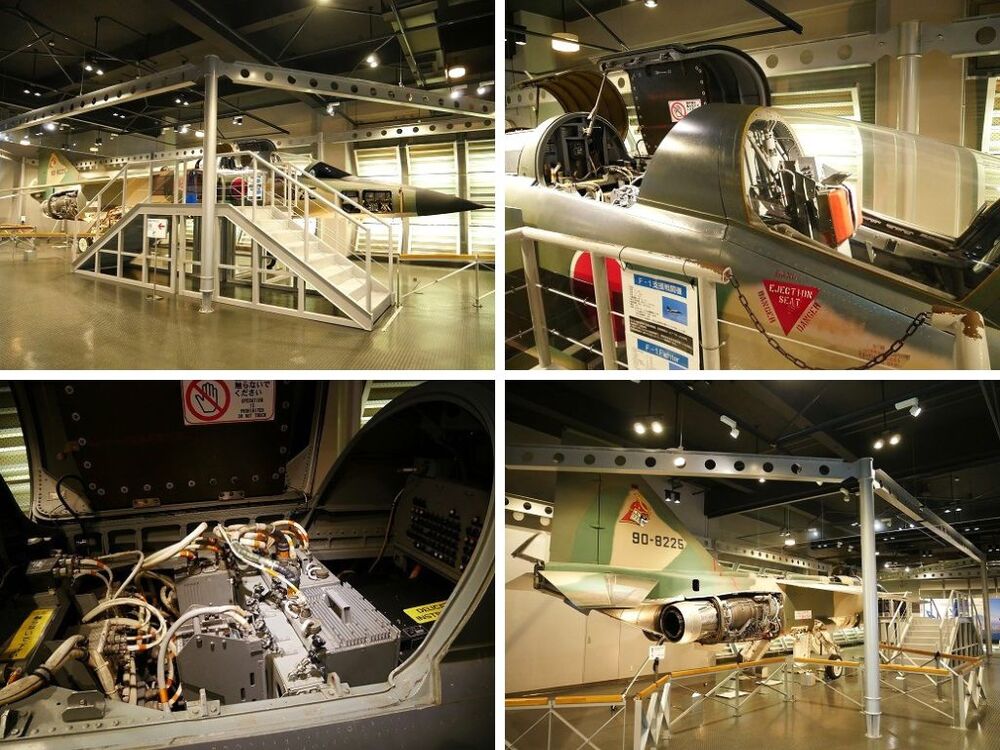
Top left: F-1 support fighter Top right: cockpit Bottom left: computer and electronic equipment room Bottom right: engine and related components
The F-1 support fighter hasn’t changed since my previous visit.
While you can’t sit in the cockpit, you can take a close look at the computer and electronic equipment room.
The fighter jet’s mechanics and the cutaway engine remained the same as before.
The entrance to the Full-Dome Theater, as well as displays of aircraft models and carried equipment, are located on the second floor!
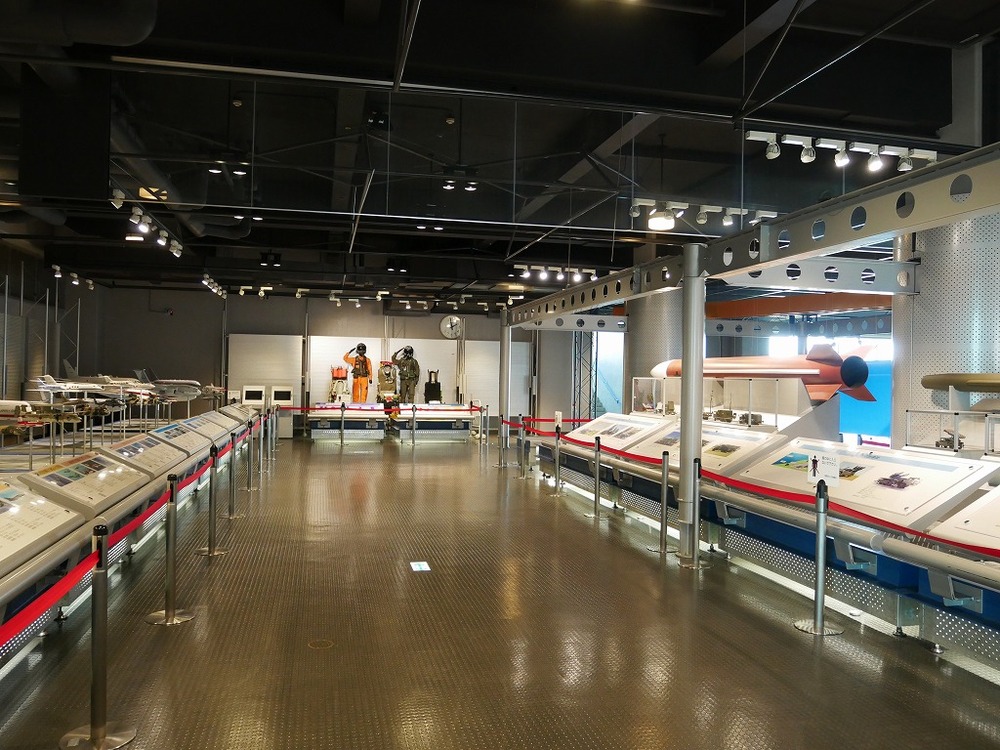
Second floor
On the second floor, you’ll find models of aircraft that have been in service since the Japan Air Self-Defense Force was founded—celebrating its 70th anniversary in 2024—as well as pilots’ carried equipment.
The entrance to the Full-Dome Theater is also on this floor.
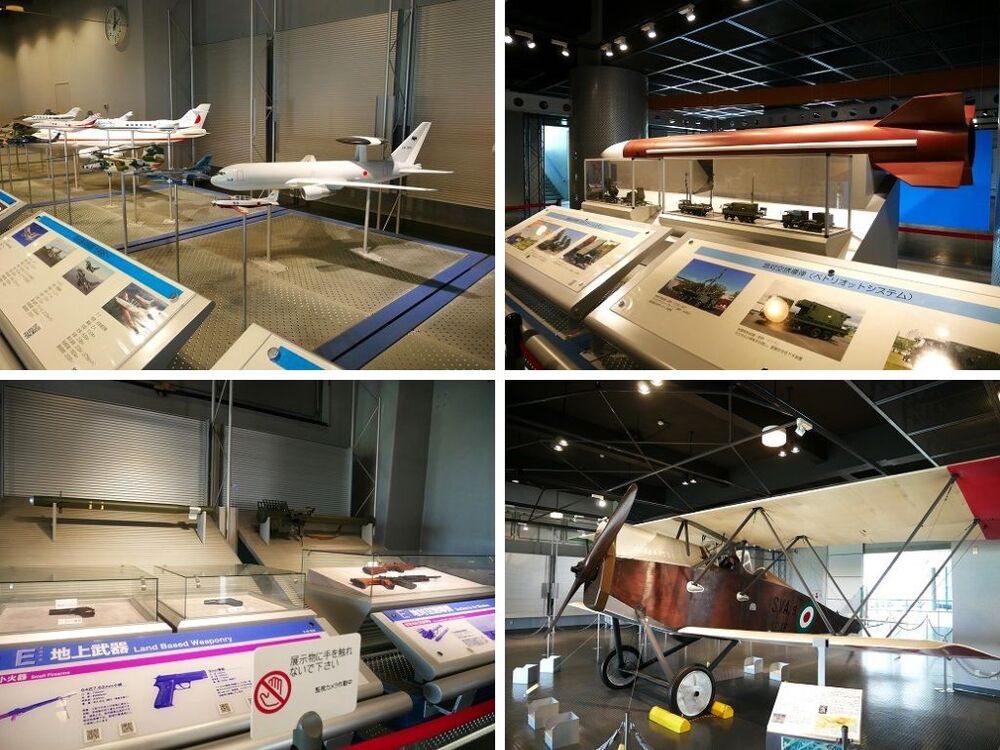
Top left: Top left: E-767 No. 1 (501) Top right: Surface-to-air guided missile Patriot (PAC-3) Bottom left: Ground-based weapons Bottom right: Replica of the SVA9
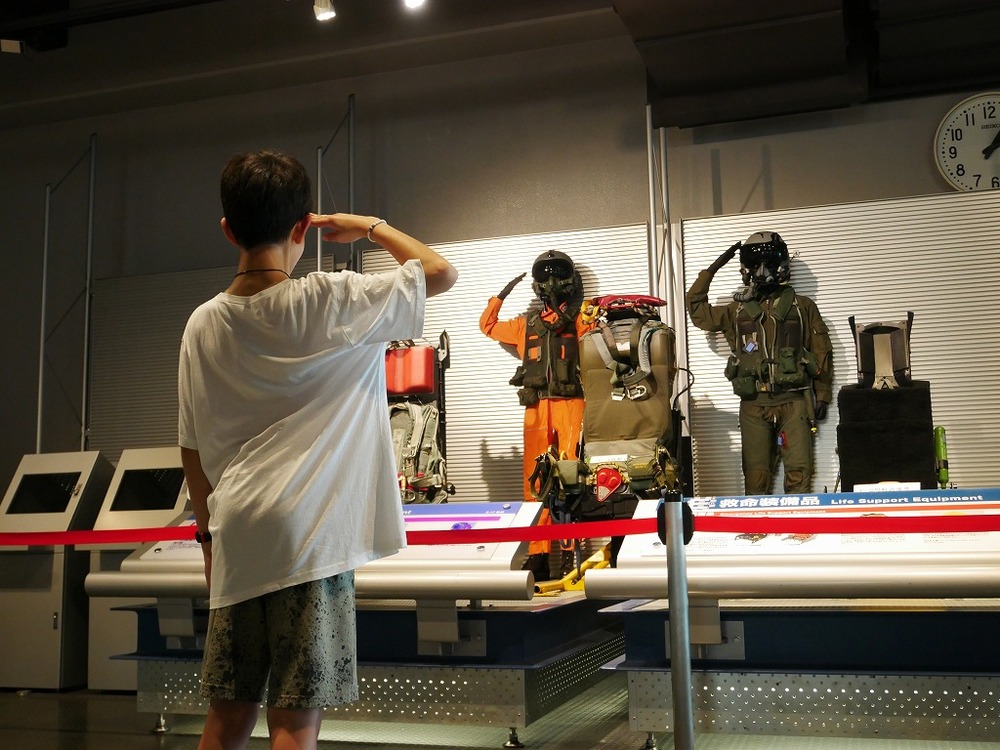
Salute to the pilots!
The aircraft models on display aren’t limited to planes currently in service.
There are also models of retired fighter jets and transport aircraft, arranged from oldest to newest as you move forward.
You might be wondering, “The panels say F-104J or T-4—but what do the letters ‘F’ and ‘T’ actually mean?”
Here’s the breakdown: T stands for Training (trainer aircraft), C for Cargo (transport aircraft), F for Fighter (fighter jet), and U for Utility (rescue or support aircraft).
The “E” in E-767 stands for “Electronic,” referring to its role as an Airborne Warning and Control System (AWACS) aircraft.
A simple way to tell it apart from a regular jumbo jet is to check for the dish-shaped radar mounted on its roof.
If you spot a jumbo jet flying over Hamamatsu, take a moment to see if it has that distinctive radar dish on top!
You’ll also find a full-scale surface-to-air guided missile Patriot (PAC-3), ground-based weapons, including the man-portable surface-to-air Stinger missile, and a replica of the ZVANAINE (SVA9) fighter, which was first developed in Italy over a century ago.
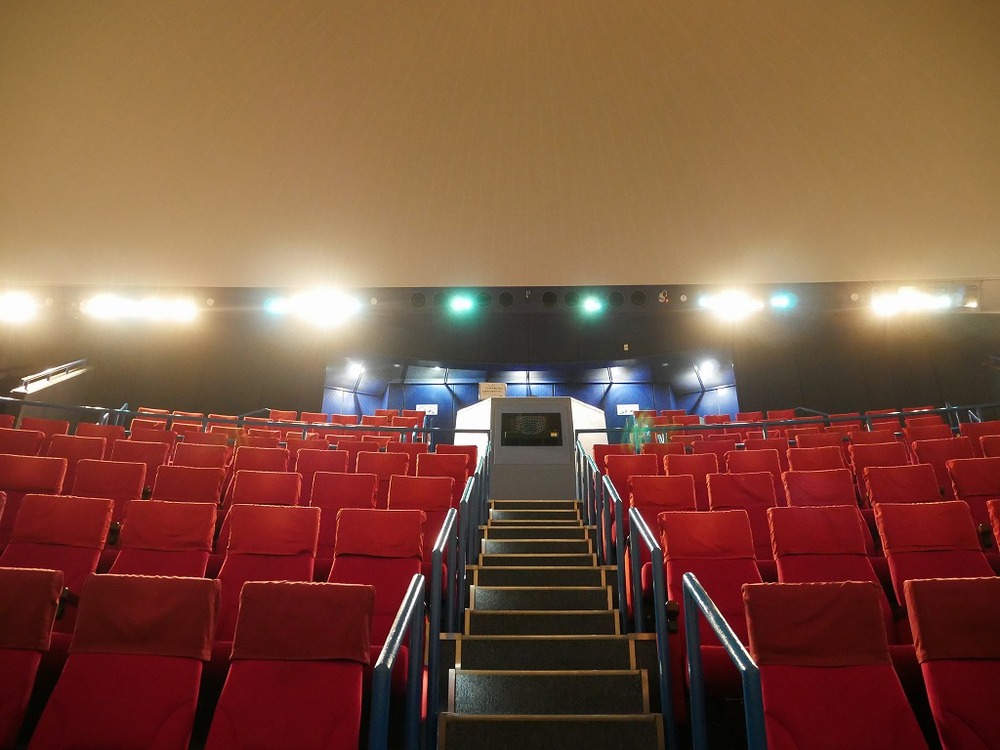
Seating in the Full-Dome Theater (from front to back) *Photography inside the Full-Dome Theater was done with permission
If you want to enjoy the views from 20,000 feet (about 6,100 meters), head to the Full-Dome Theater.
As mentioned earlier, a numbered ticket is required to watch the show.
Tickets are distributed at the reception on the first floor, with each screening limited to 120 people (matching the number of seats).
Since there’s no reservation system, be sure to pick up your ticket before entering the Exhibition Hall.
The dome measures 15 meters in diameter, and the images flow smoothly from the back to the front.
So if you sit in the front and try to watch the footage coming from the back, your neck might start to ache!
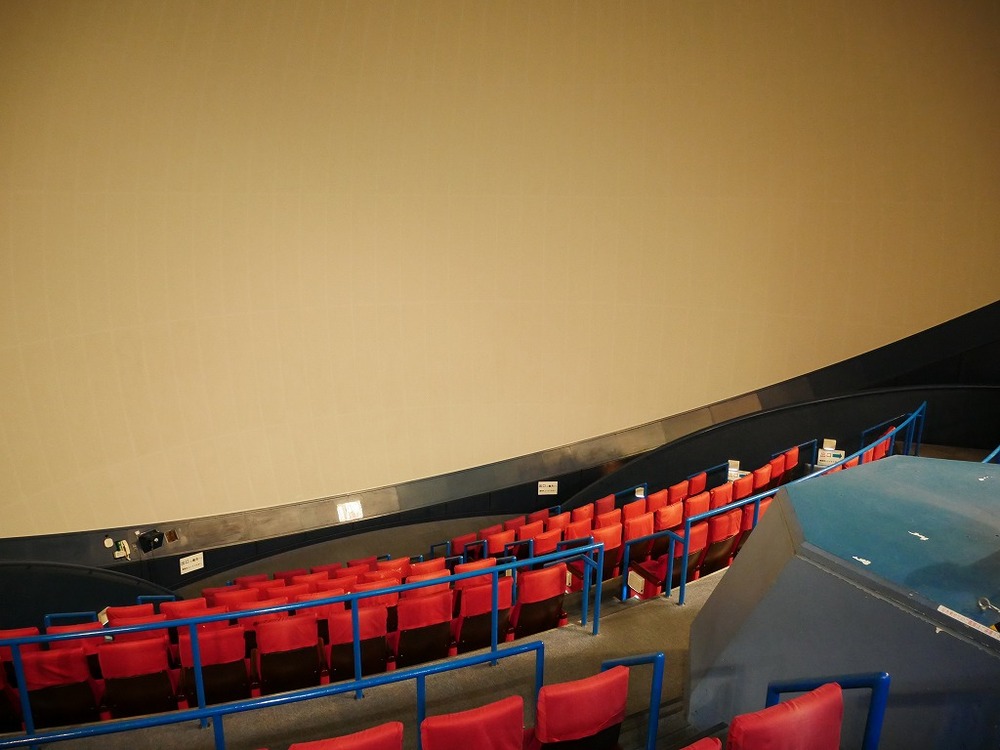
Seating in the Full-Dome Theater (from back to front) *Photography inside the Full-Dome Theater was done with permission*
The screening content changes periodically, and one program is shown from a selection of five.
The programs feature dynamic flight scenes by fighter units and Blue Impulse, as well as the activities of transport units during disaster relief.
Be sure to catch these thrilling films showcasing the missions of the Japan Air Self-Defense Force!
*Wheelchair-accessible seating available (2 seats at the very back)
You can check out the former government aircraft and try the Blue Impulse simple simulator on the third floor
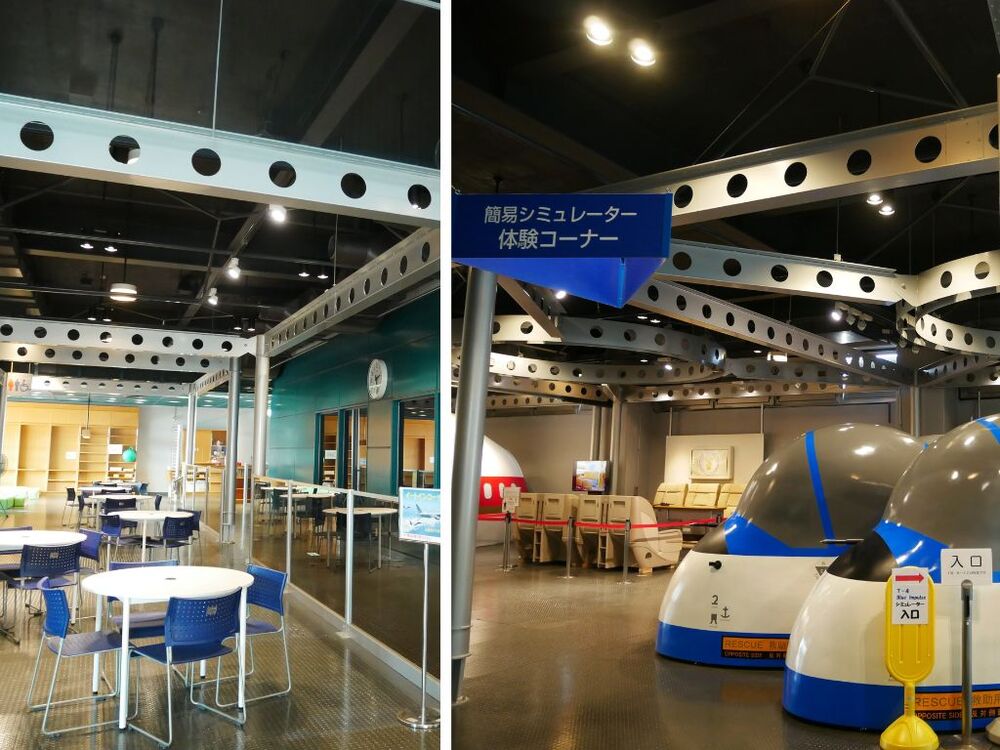
Left: Eat-in area Right: Simple simulator experience corner
On the third floor, which also serves as the exit for the Full-Dome Theater, you can try the simple simulator, and tour the former government aircraft (B747-400), including the royal room and press conference seats.
You can also use the eat-in area, so if you bring a bento, you can enjoy a leisurely visit (please take your trash with you).
The café, Café FUJI, is located at the back right of the eat-in area.
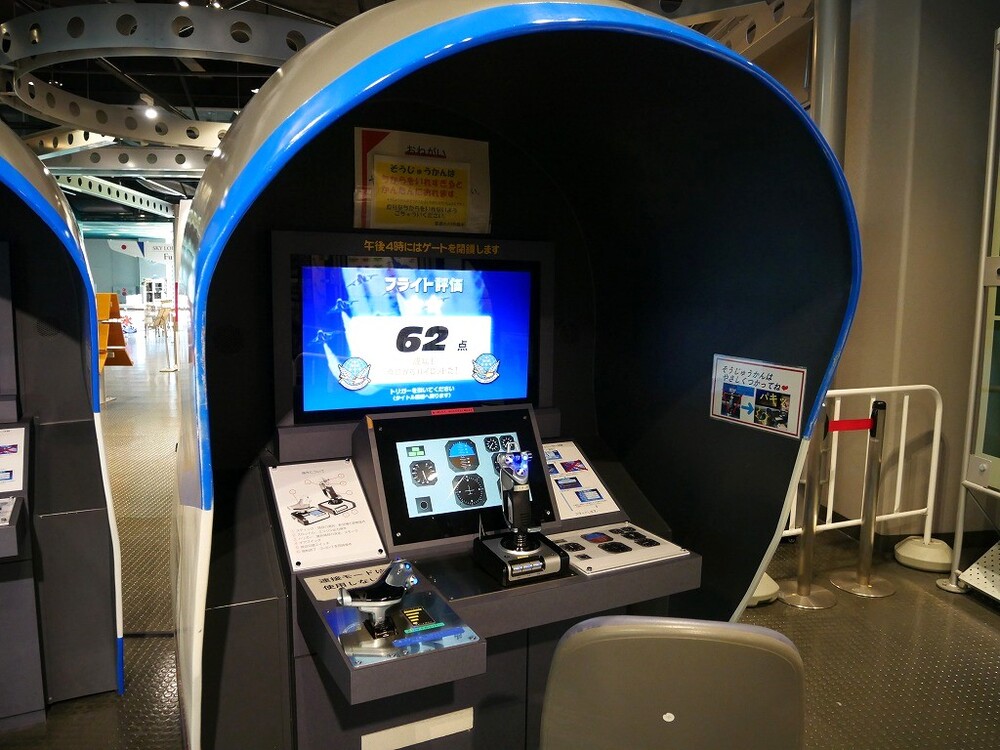
Simple simulator
The simple simulator offers three flight courses: beginner, intermediate, and advanced.
You’ll pilot the aircraft as a member of the T-4 Blue Impulse team.
Instructions, such as how to operate the triggers, are displayed on monitors to the left and right, so even first-timers can enjoy the experience.
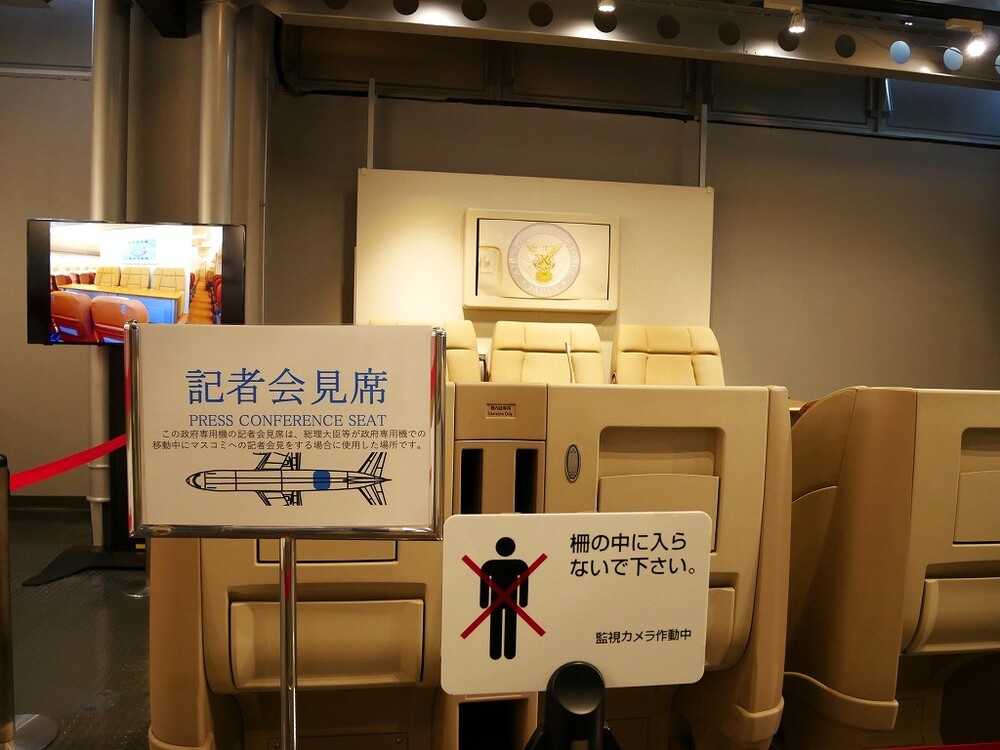
Press conference seats in the former government aircraft
The former government aircraft (B747-400) on display at Air Park was actually in service from 1992 to 2019.
Just thinking that the chairs and tables on display were actually used in real press conferences is enough to get your heart racing.
At Air Park, only the press conference seats and the royal room are on display, but the adjacent monitors show footage of the interior.
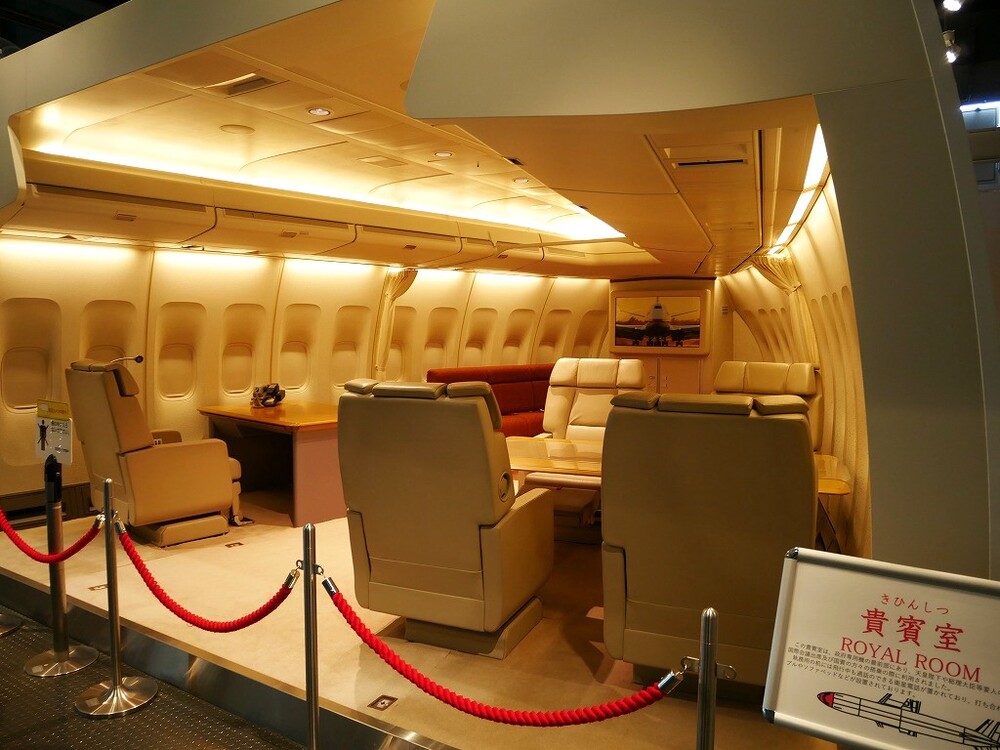
The royal room of the former government aircraft
The royal room of the former government aircraft is located next to the press conference seats.
Situated at the very front of the aircraft, the royal room features a desk for official work, a meeting table, sofas, and even a bed.
On the desk, there’s a satellite phone that can be used even while the plane is in flight.
More than just exhibits! The Exhibit Hangar is full of hands-on experiences too.
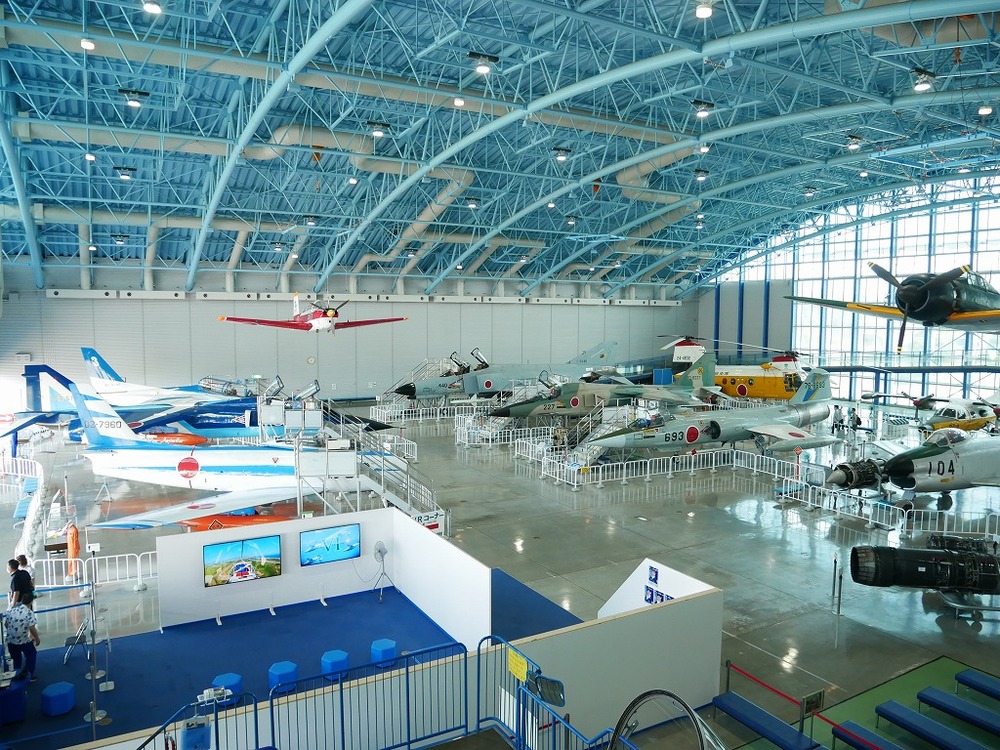
Exhibit Hangar viewed from the connecting passage to the Exhibition Hall
At Air Park, you don’t have to see every exhibit.
“I don’t have much time today, so I’ll just visit the Exhibit Hangar” is perfectly fine.
You can enter the Exhibit Hangar directly from outside, or via the connecting passage from the second floor of the Exhibition Hall.
The image above shows the view after crossing the connecting passage from the second floor of the Exhibition Hall.
Hmm? Compared to before the renovation, it looks like there are fewer yellow aircraft…?
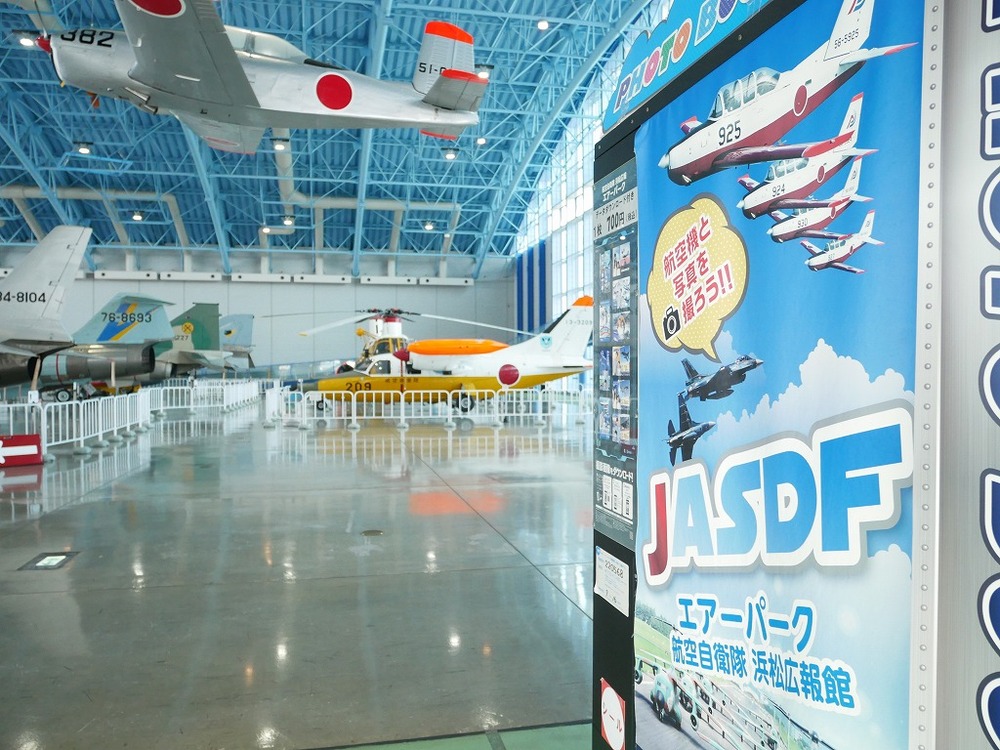
From the first-floor entrance of the Exhibit Hangar
If you enter from outside, it looks like this.
Right in front of you are rescue and fighter aircraft!
The Exhibit Hangar also offers a variety of experiences.
You can climb into a fighter jet cockpit, try out the flight simulator, or wear a flight suit.
Since the renovation, there’s even a Blue Impulse VR experience.
And the best part?
Everything is completely free!
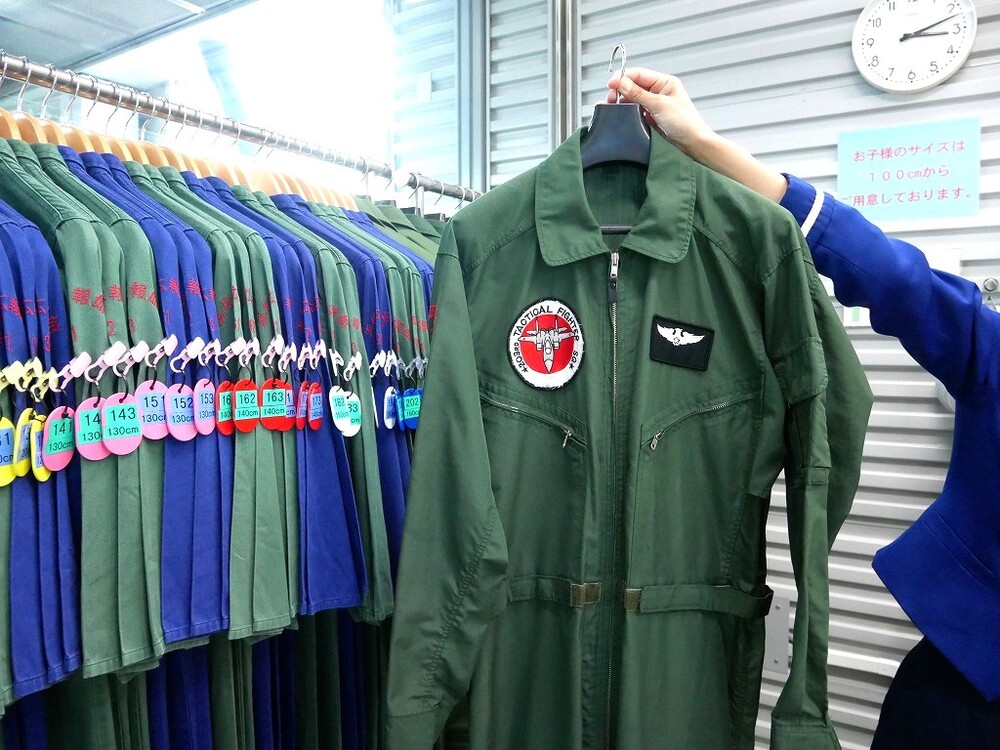
The flight suits are available for heights ranging from 100 to 185 cm.

Top left: Flight boots are available in sizes 24.0–28.0 cm (socks required) Right: It’s great that the flight suits can be worn by children who can stand and walk
If you want to try on a flight suit, head to the Factory reception inside the Exhibit Hangar.
You can borrow a flight suit, flight boots, and a helmet.
The experience lasts 15 minutes and is available only on the first floor of the Exhibit Hangar.
Not only can you try it on, but you can also sit in a fighter jet cockpit while wearing the suit!
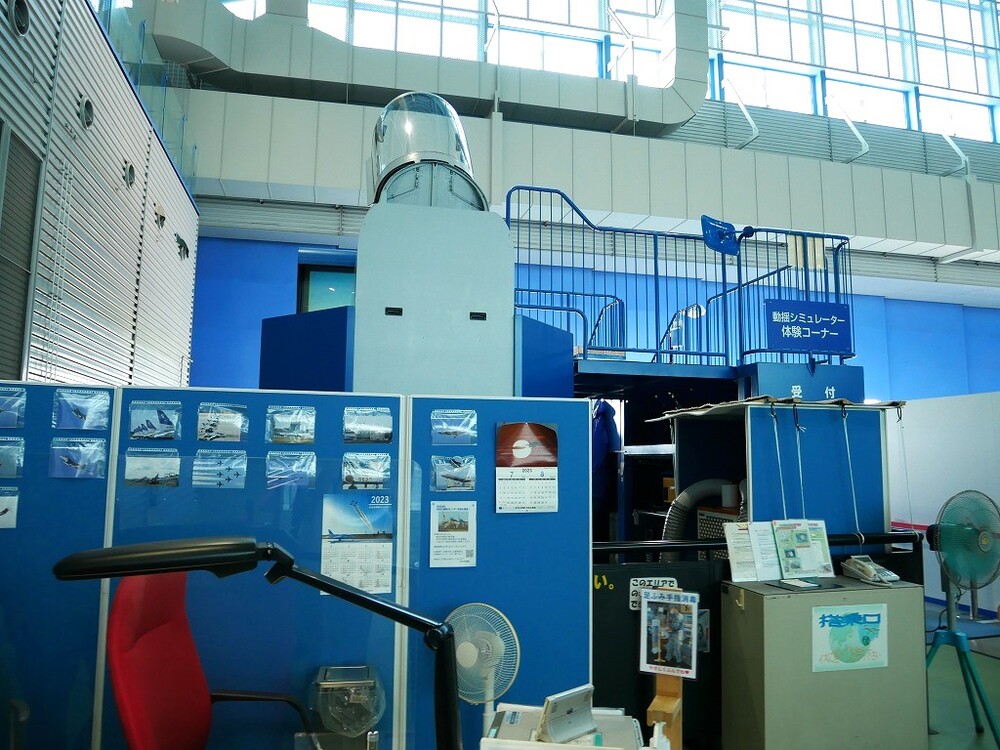
Flight simulator
The flight simulator is famous for letting you experience piloting an F-1 fighter jet!
There are three courses available: beginner, intermediate, and advanced.
The advanced course even lets you try aerial combat!
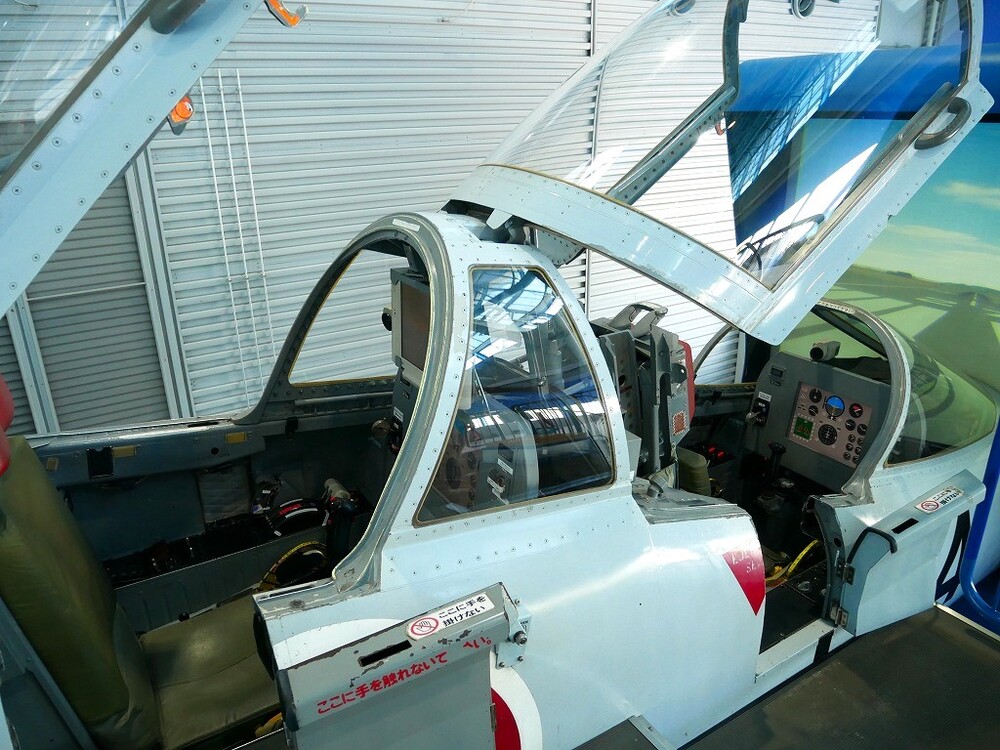
The simulator is designed in authentic T-2 style
While the simulator itself is fairly simple, the seat and components are modeled closely on a real T-2, so there are some authentic features.
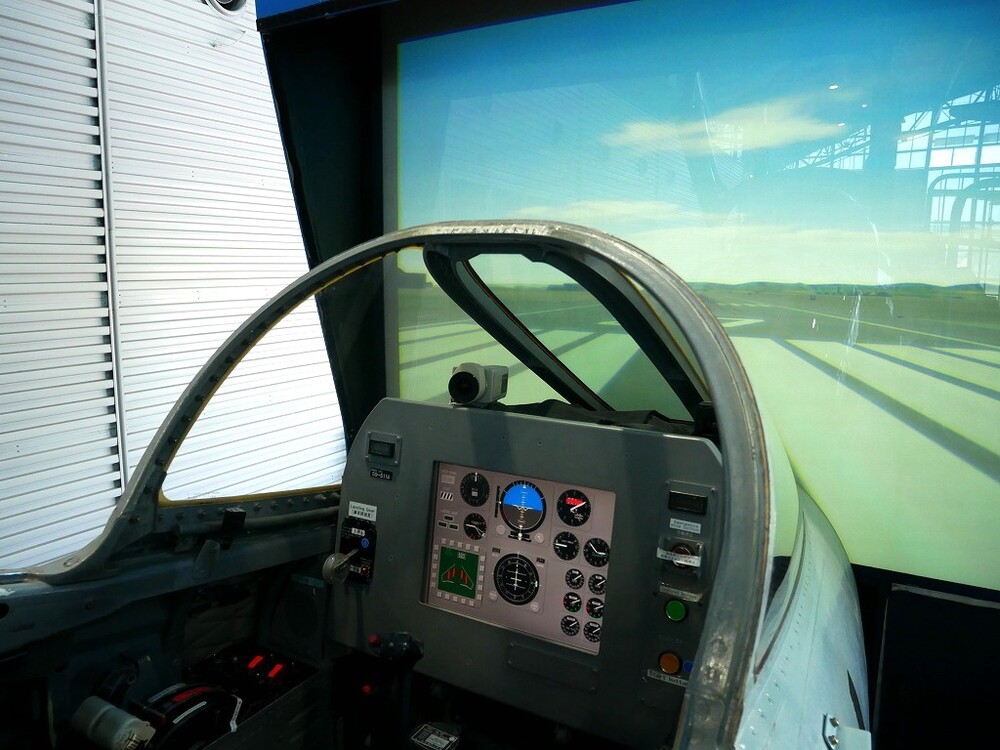
Take off while watching the front monitor!
Once you’re seated in the cockpit, the flight experience begins as you watch the front monitor.
Some visitors even practice on the simple simulator on the third floor of the Exhibition Hall before giving it a try.
For more details about the flight suit experience and the flight simulator, please check the official website.
★Official website (Japanese link): https://www.mod.go.jp/asdf/airpark/
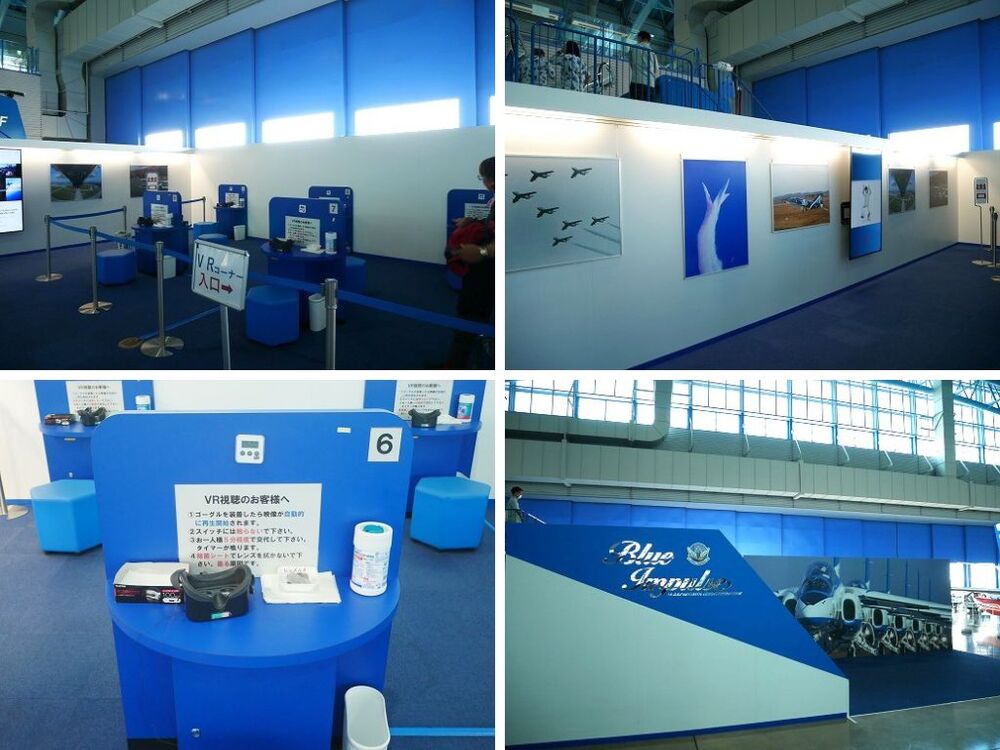
Top left: Blue Impulse VR experience corner Top right: Blue Impulse panels on the wall Bottom left: VR goggles for the experience Bottom right: Marked with Blue Impulse
Since the renovation, you can also enjoy a Blue Impulse VR experience.
Up to seven people can participate at a time.
Wearing the VR goggles, you can experience the view from the cockpit of a Blue Impulse aircraft.
There are a total of five videos to watch: Video 1 is from Hamamatsu Air Base, and Videos 2–5 are from Matsushima Air Base.
If you live in Hamamatsu, you might even spot some familiar scenery!
The videos also showcase the maneuvers, like low-angle Cuban takeoffs and four-point rolls.
The corkscrew and dead cross are performed at Matsushima Air Base.
Ah—so cool…!!
Take a seat in the fighter jet cockpit!
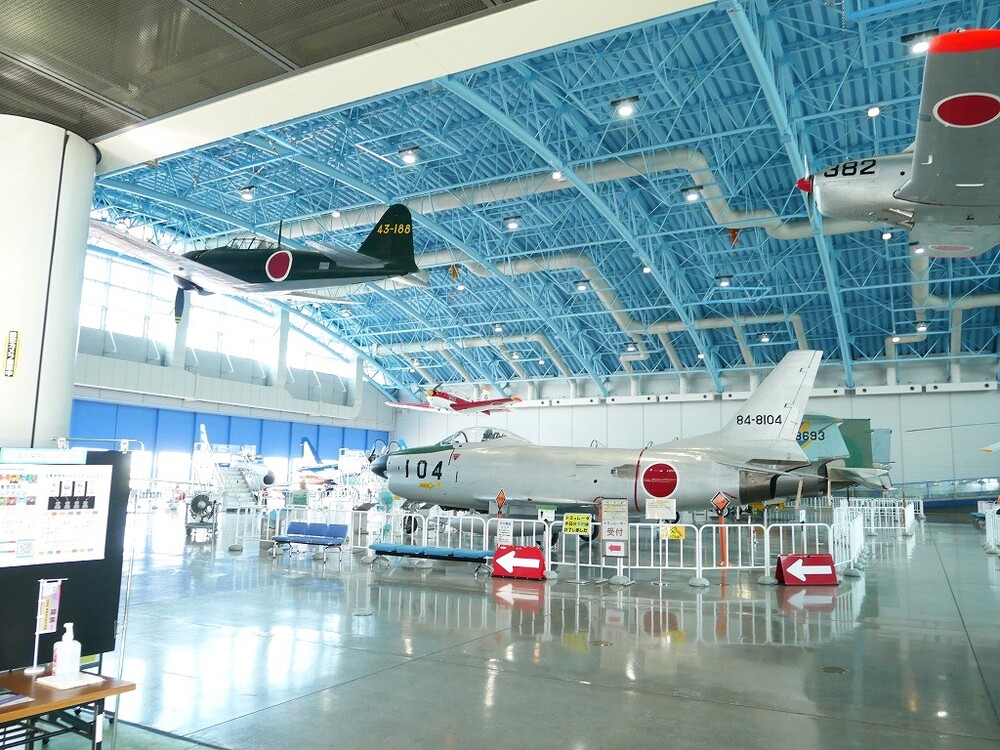
First floor of the Exhibit Hangar (F-86D in the center)
If you want to try the cockpit experience, head directly to the fighter jet you’d like to board.
However, please note that the F-4 is off-limits.
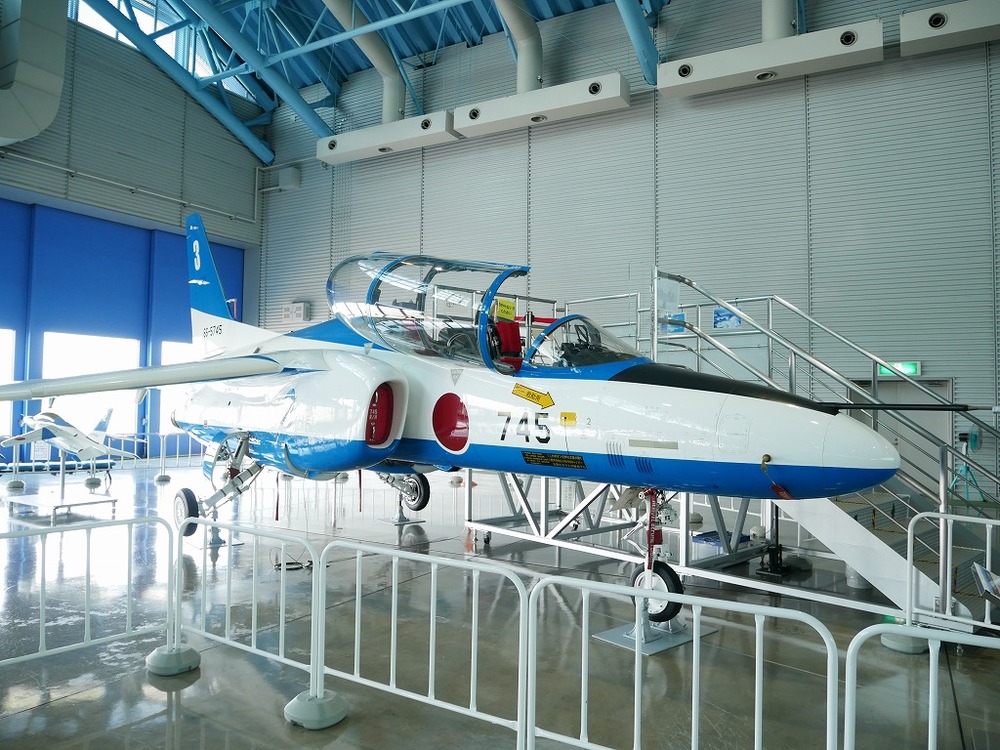
T-4 (look for the “745” on the aircraft)
At the back left of the Exhibit Hangar, three aircraft—F-86F, T-2, and T-4—are on display, all of which served as part of the Blue Impulse team.
The T-4, currently the third-generation aircraft of Blue Impulse, is located at the very back of the Exhibit Hangar.
Even though it’s a display aircraft, wouldn’t it be thrilling to sit in the cockpit of your beloved Blue Impulse?
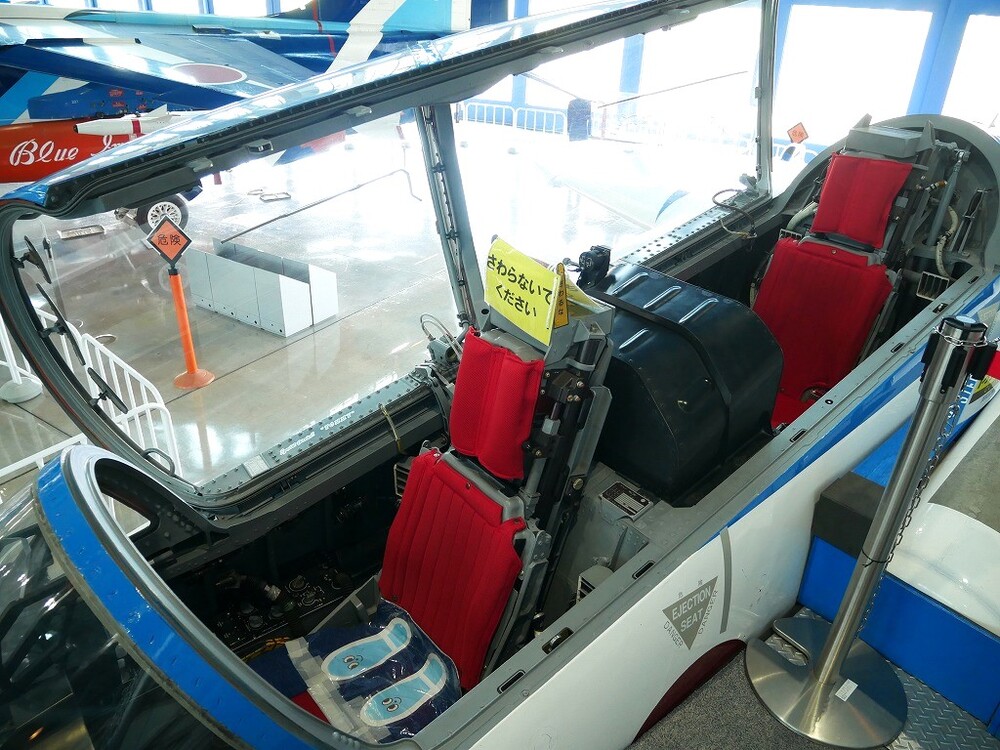
T-4 Cockpit
The T-4 has two crew seats, but for the cockpit experience, only the front seat is available.
The interior is surprisingly deep, with a high seat and plenty of legroom, so you can even enjoy it together with a child.
Please follow the staff’s instructions during each experience.
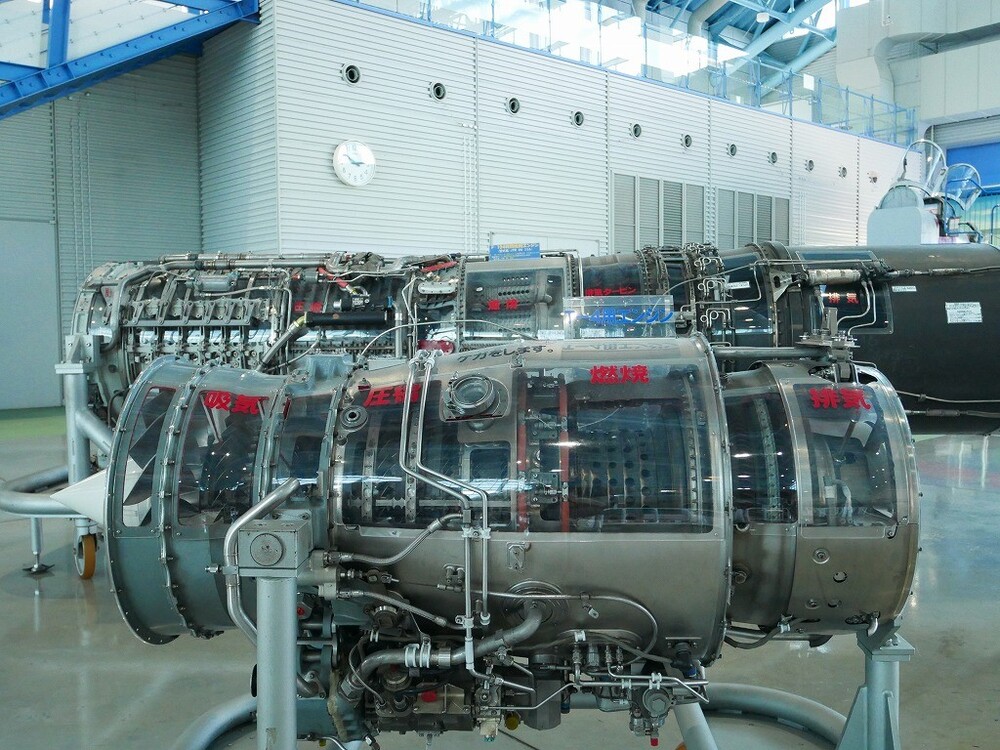
Engines of the T-4 (front) and F-104J (back)
The Exhibit Hangar also features fighter jet engines on display.
If you’re interested, be sure to check them out too.
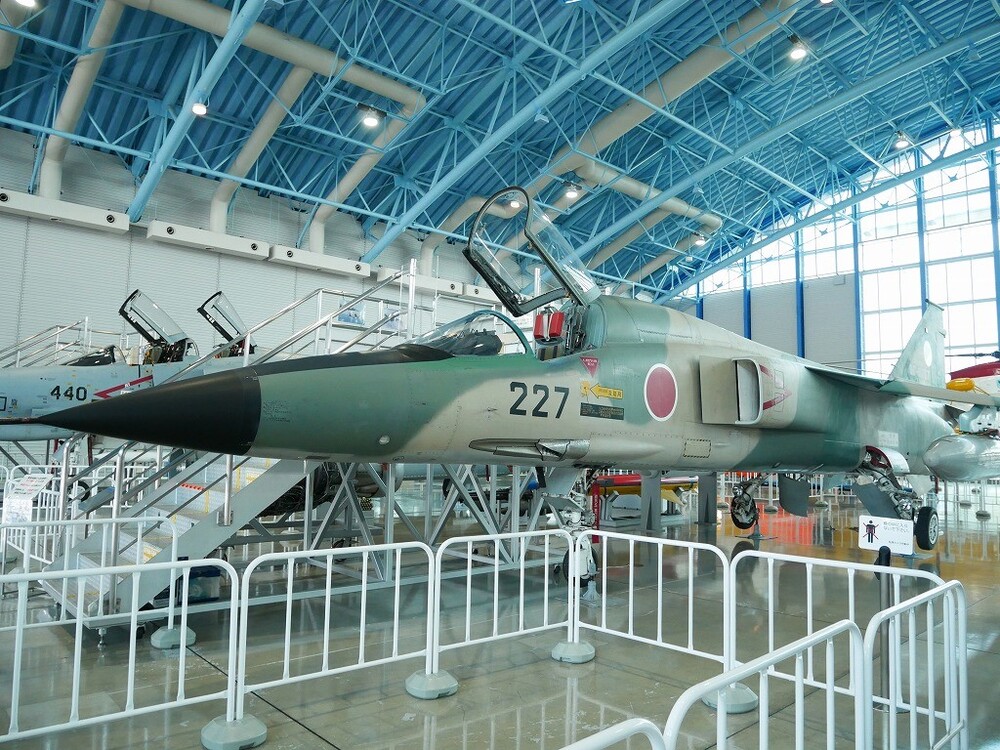
F-1, No. 227
In the central row of the Exhibit Hangar, four aircraft are lined up from front to back: F-86D, F-104J, F-1, and F-4.
The F-1 fighter can be identified by the large “227” painted on its fuselage.
This aircraft was Japan’s first supersonic support fighter, equipped with domestically produced radar fire-control systems and air-to-ship missiles.
The F-4 displayed just behind it was the last F-4 ever produced in the world.
Both are truly valuable aircraft.
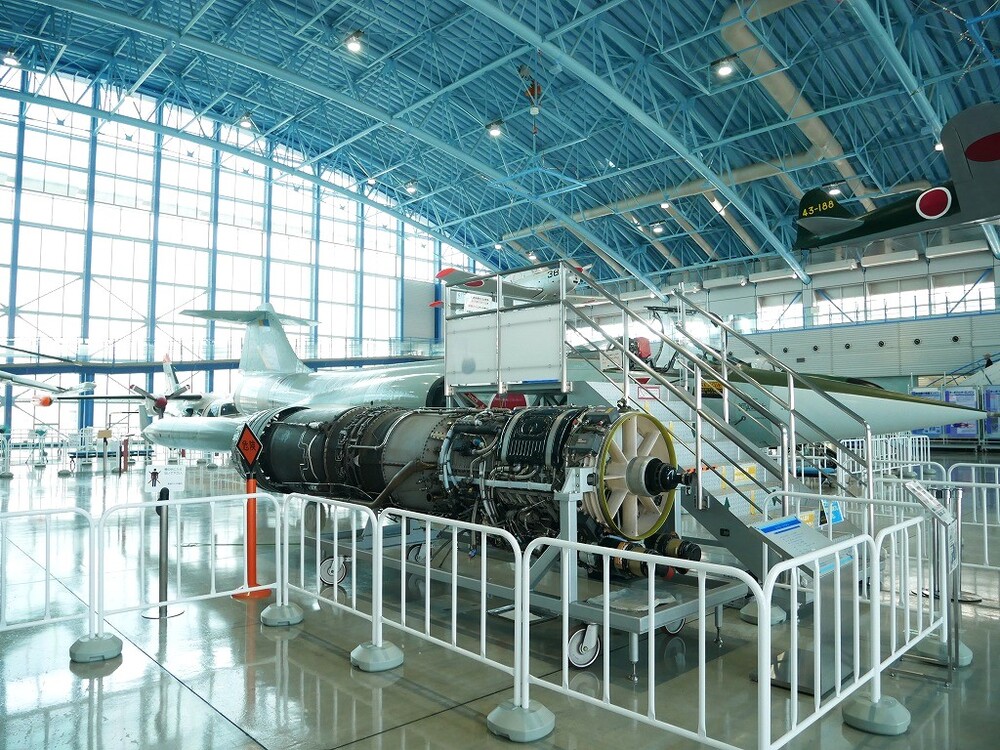
F-104J Engine
Next to each aircraft, the engine it was equipped with is on display.
All the fighter jets and other aircraft also have explanatory panels.
Comparing the sizes of the engines and reading the panels as you explore makes the visit even more enjoyable.
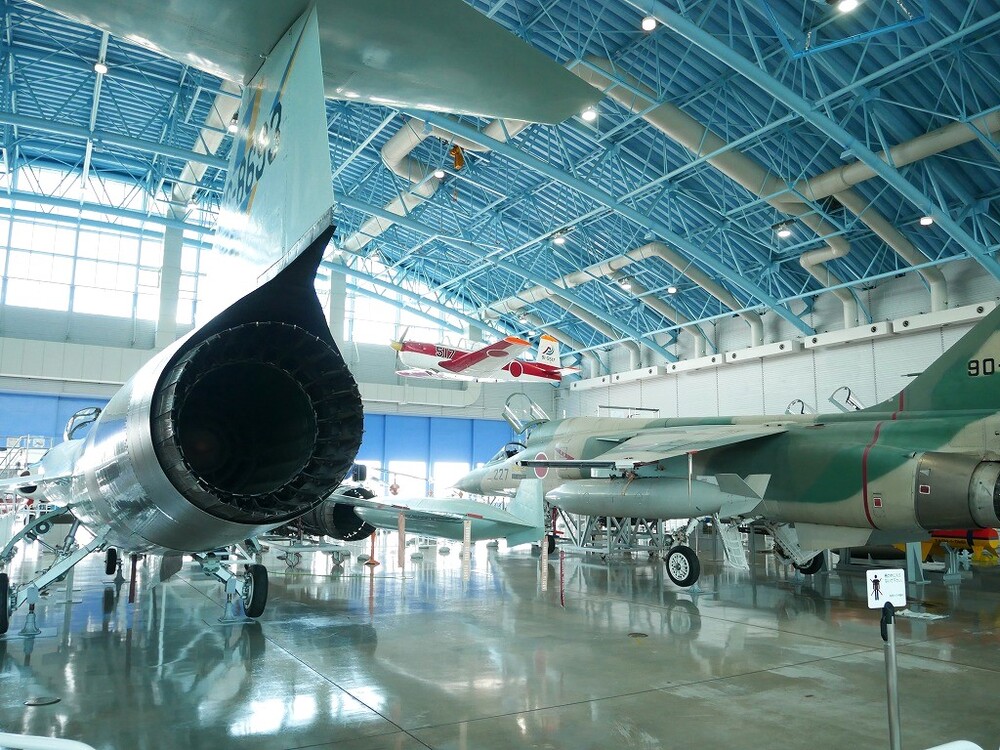
F-104J Viewed from the Rear
The image above shows the F-104J from the rear.
When I first saw the augmenter—a device that temporarily boosts engine thrust—I was completely overwhelmed by its size.
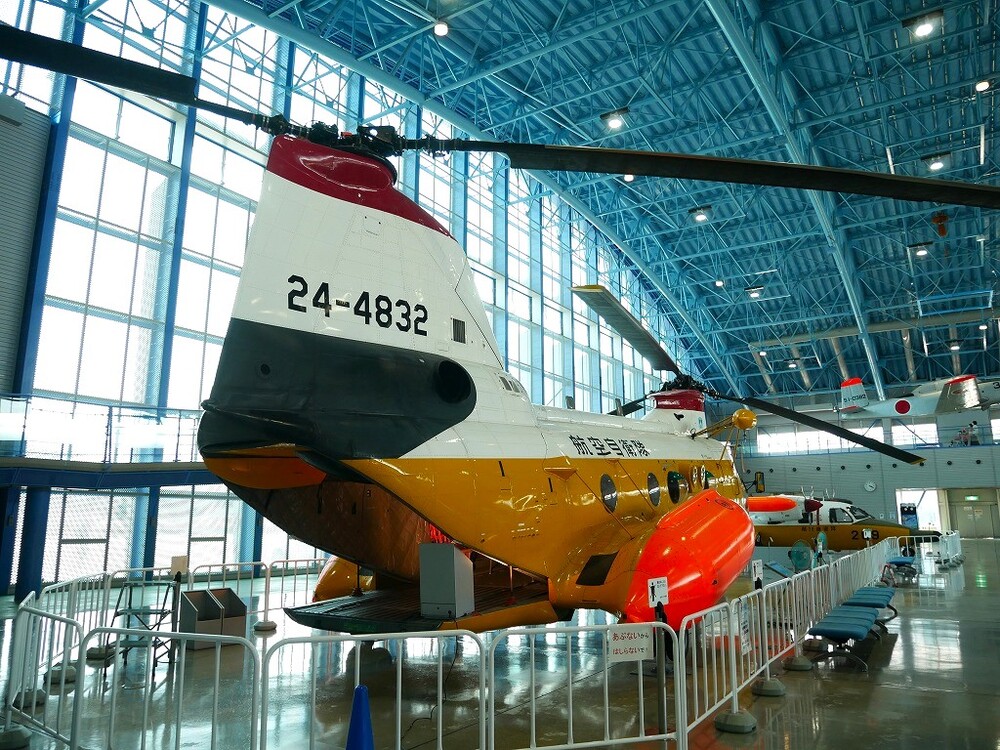
Rescue Helicopter V-107A
Before the renovation, the rescue helicopter V-107A was displayed in the central row, but it has since been moved to the back near the entrance.
The same type of aircraft has been deployed for search and rescue missions in various situations, including the 2004 Chuetsu Earthquake, saving many lives.
At the museum, you can peek inside the helicopter behind the barrier, so be sure to take a look.
The MU-2 near the front on the entrance side is also a search and rescue aircraft.
There are also outdoor exhibits! For souvenirs, head to the gift shop.

At Air Park, in addition to the indoor exhibits, there’s an outdoor display area where you can see large aircraft and missile launchers.
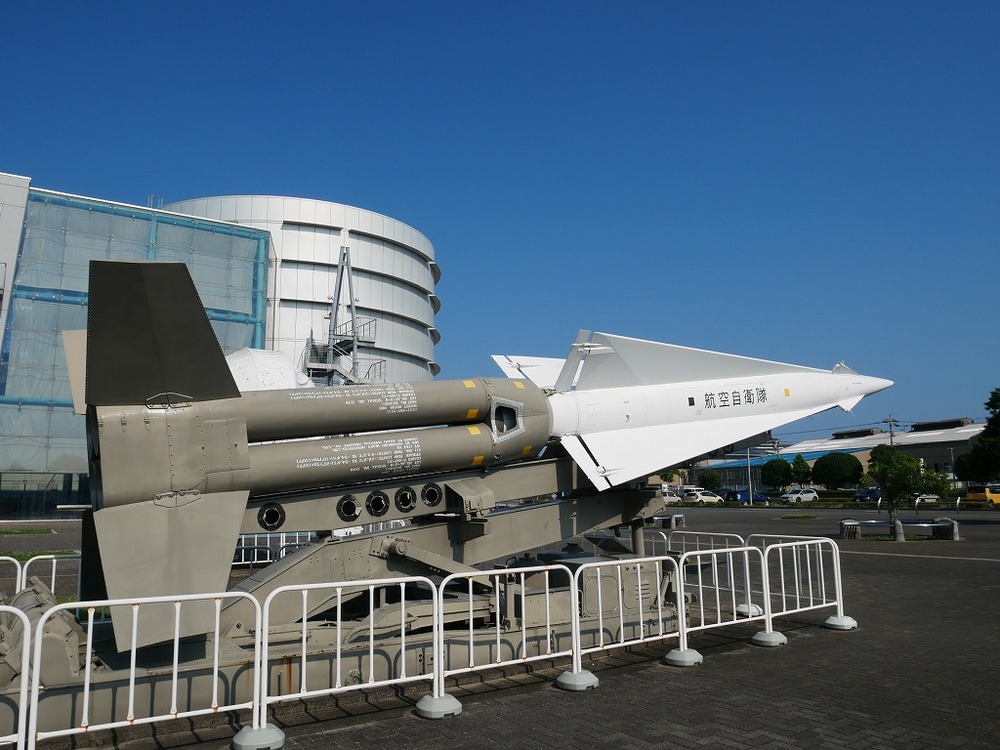
Launcher (Missile Launcher)
The image above shows the launcher for the Nike-J, a surface-to-air missile system that preceded the Patriot.
Its size might surprise you!
Note: Painting work is scheduled from Friday, February 2, 2024, until mid-March.
Transport aircraft like the C-46 and rescue helicopter H-21 are also on display.
The H-21, an aircraft operated in the 1960s, is notable for its appearance, which somewhat resembles a banana.
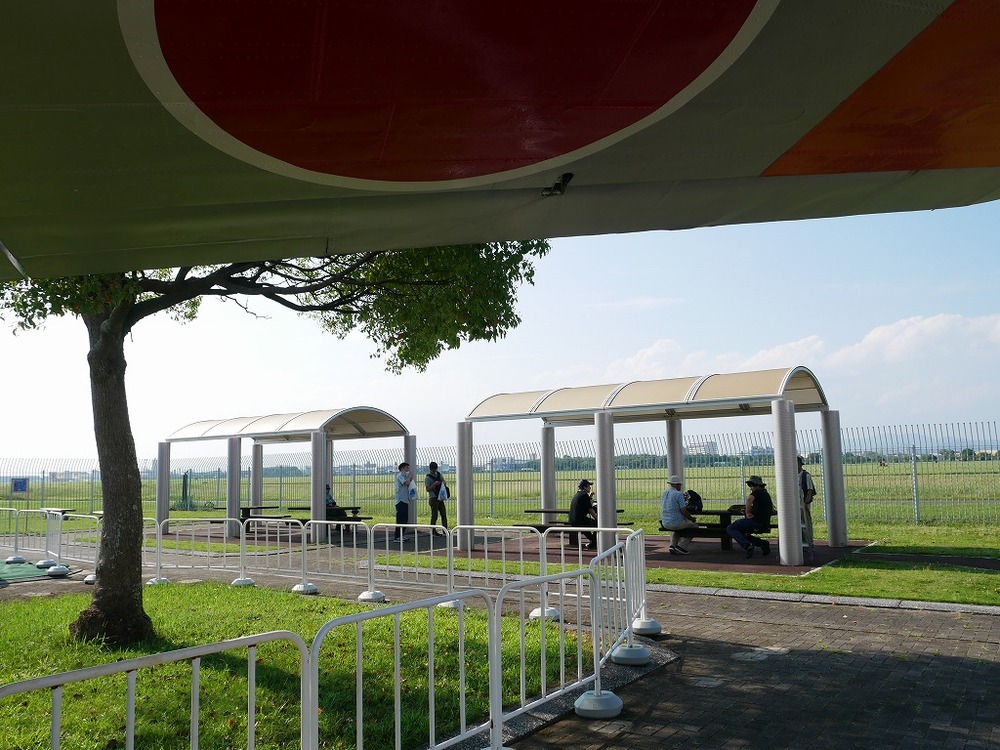
One corner of the outdoor display area serves as a rest area.
It features vending machines, benches, and even playground equipment for children.
At the benches near the outer fence of Hamamatsu Air Base, you’ll often see people watching or photographing aircraft as they pass by.
If you’ve finished your tour and want to pick up some souvenirs, head to the gift shop in front of the reception on the first floor of the Exhibition Hall.
The shop offers goods not only from Hamamatsu Air Base but also from other bases, as well as local Hamamatsu souvenirs.
Highlights include Air Park originals like Fool Sec and the Air Self-Defense Force Karaage Canned Chicken, plus plenty of Blue Impulse-themed merchandise!
Official website (Japanese link): https://www.mod.go.jp/asdf/airpark/
 ̄ ̄ ̄ ̄ ̄ ̄ ̄ ̄ ̄ ̄ ̄ ̄ ̄ ̄ ̄ ̄ ̄ ̄
The average visit to Air Park takes about 1–2 hours.
That said, if you take your time exploring the exhibits and trying out the experiences, it may take a little longer.
Some visitors even enjoy a break at the café on the third floor or the eat-in area.
At the Japan Air Self-Defense Force Hamamatsu Public Relations Museum—Air Park—let yourself feel the romance of the open skies.
*Exhibit content is subject to change.

Hamamatsu Fruit Park Tokinosumika: Enjoy Fruit Picking, Camping, and Glamping
